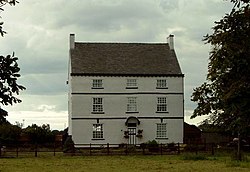Lowton: Difference between revisions
Created page with '{{Infobox town |name=Lowton |county=Lancashire |picture=Byrom Hall, Slag Lane Lowton - geograph.org.uk - 1403901.jpg |picture caption=Byrom Hall, ancestral home of the Byrom fami…' |
No edit summary |
||
| Line 14: | Line 14: | ||
|constituency=Leigh | |constituency=Leigh | ||
}} | }} | ||
'''Lowton''' is a village in southern [[Lancashire]], whose main nearby town is [[Wigan]], | '''Lowton''' is a village in southern [[Lancashire]], whose main nearby town is [[Wigan]], six miles to the north. It is around three miles from [[Leigh, Lancashire|Leigh]]. The A580 East Lancashire Road runs through the village. | ||
Lowton's early history is marked by its presence of Byrom Manor, the ancestral home of Byroms, the family that included poet John Byrom who invented a system of shorthand. | Lowton's early history is marked by its presence of Byrom Manor, the ancestral home of Byroms, the family that included poet John Byrom who invented a system of shorthand. | ||
Latest revision as of 08:03, 15 August 2014
| Lowton | |
| Lancashire | |
|---|---|
 Byrom Hall, ancestral home of the Byrom family | |
| Location | |
| Grid reference: | SJ622973 |
| Location: | 53°28’16"N, 2°34’11"W |
| Data | |
| Post town: | Warrington |
| Postcode: | WA3 |
| Dialling code: | 01942 / 01925 |
| Local Government | |
| Council: | Wigan |
| Parliamentary constituency: |
Leigh |
Lowton is a village in southern Lancashire, whose main nearby town is Wigan, six miles to the north. It is around three miles from Leigh. The A580 East Lancashire Road runs through the village.
Lowton's early history is marked by its presence of Byrom Manor, the ancestral home of Byroms, the family that included poet John Byrom who invented a system of shorthand.
The origin of Lowton's name is not certain, but it does appear to mean "Low town" (or "low village"), but it is now low down, and indeed is one of the highest places around, so "Low" may mean "hill" instead, form the Old English hlaw, found as "Low" or "Law" in countless hill names. A record of the name as Liewetune in 1176 suggests instead the Old English hleowe, meaning lee", although again this is far from certain.
History
Lowton was one of the berewicks of the Royal Manor of Newton, later being one of the members of the Barony of Makerfield.[1] Byrom Manor, later to feature the ancestral home of the poet John Byrom and was constructed during the 18th century, is recorded as early as 1212,[1] where the family prospered for centuries. Byrom Hall at one time featured a moat.[2]
The Hare and Hounds public house, built in the 17th century, was once used by the magistrates as a place to hold their sessions including criminal trials.
In 1830 Parkside, Newton-le-Willows, near Lowton, was the site of the world's first fatal passenger train crash, when Liverpool MP William Huskisson was killed after being hit by George Stephenson's Rocket locomotive during the opening of the Liverpool and Manchester Railway.[3]
The former Lowton railway station was used as a resting point for the royal train.[4]
Lowton had a toffee factory,[5] along with other sites of heavy industry. In common with many parts of the United Kingdom, many of these factories have now closed and been replaced with some light industry.
Transport links
Situated on the A580 East Lancashire Road, the village has direct access to the cities of Liverpool to the west and Manchester to the east. From this road, the M6 motorway runs north and south, and the M60 connects with the M62 across the Pennines.
The nearest railway station is Newton-le-Willows on the Chester to Manchester Line and Liverpool to Manchester Line.
Environment
To the south of Lowton is Highfield Moss, part of which has been designated a Site of Special Scientific Interest. The 52.6 acre site was designated in 1986 for its biological interest. The interest is predominantly mire communities of which it is the best example in south Lancashire.
Churches
Lowton has six churches:
- Church of England:
- St Mary's
- St Luke's
- Evangelical: Lowton Christian Fellowship
- Methodist:
- Lane Head (closed 2010)
- Lowton Independent Methodist
- Roman Catholic: St Catherine
The churches organise certain activities jointly, including ecumenical services. Their joint charity work included the Lowton Churches Romania Appeal, formed after the collapse of the Communist regime in Romania during 1990. It initially supported an orphanage in Lugoj but its remit has expanded to include several ongoing projects in Romania.
Media
Lowton falls inside the circulation areas of these newspapers and websites:
- Wigan Evening Post
- Wigan Reporter
- Leigh Reporter
- Leigh Journal
- Manchester Evening News
Outside links
- A Piece of Lowton History
- Community info
- Links to many Lowton interest websites
- 1st Lowton St Marys Scout Group
References
- ↑ 1.0 1.1 Lowton - British History On-Line
- ↑ "Lowton History - History and Photographs of Lowton and district (1)". http://www.freewebs.com/notwol2/buildings.htm. Retrieved 2006-12-09.
- ↑ "Lowton History - Hoskinsson". http://www.freewebs.com/notwol2/huskisson.htm. Retrieved 2006-12-09.
- ↑ "Lowton History - Transport". http://www.freewebs.com/notwol2/transport.htm. Retrieved 2006-12-09.
- ↑ "Lowton History - History and Photographs of Lowton and district (2)". http://www.freewebs.com/notwol2/employment.htm. Retrieved 2006-12-09.
Books
- Nixon, Alan (2004). A Piece of Lowton History. www.lulu.com/lowton.
- Worsley, Bert (1993). Pictoral History of Old Lowton. H.Worsley. ISBN 0-9511102-2-5.